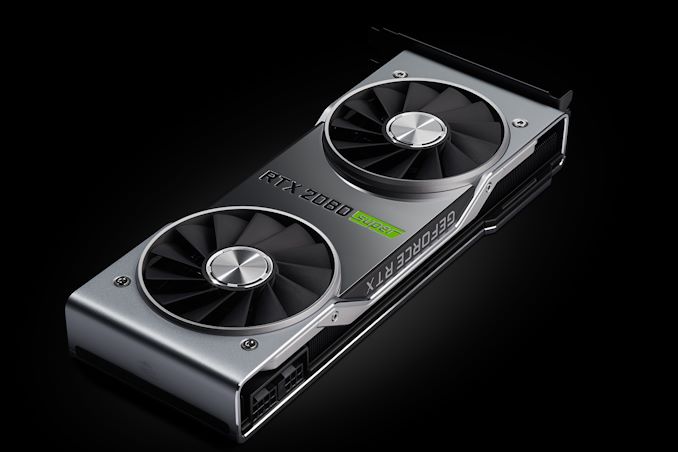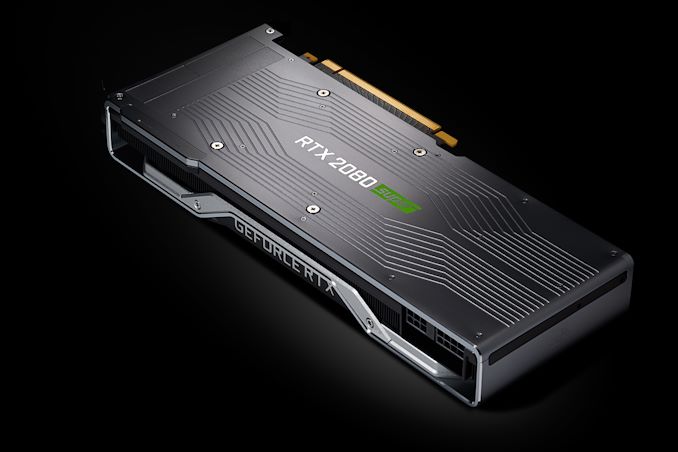The NVIDIA GeForce RTX 2080 Super Review: Memories of the Future
by Ryan Smith on July 23, 2019 9:00 AM EST- Posted in
- GPUs
- GeForce
- NVIDIA
- Turing
- GeForce RTX
Meet the GeForce RTX 2080 Super Founders Edition
Taking a closer look at the RTX 2080 Super, there aren’t too many surprises to be found. Since we’re dealing with a mid-generation kicker here, NVIDIA has opted to stick with their original RTX 2080 reference designs for the new card, rather than design wholly new boards. This has allowed them to get the new card out relatively quickly, and to be honest there’s not a whole lot NVIDIA could do here that wouldn’t be superficial. As a result, the RTX 2080 Super is more or less identical to the RTX 2080 it replaces.
| GeForce RTX 20 Series Card Compariaon | ||||
| RTX 2080 Super Founders Edition |
RTX 2080 Super (Reference Specs) |
|||
| Base Clock | 1650MHz | 1650MHz | ||
| Boost Clock | 1815MHz | 1815MHz | ||
| Memory Clock | 15.5Gbps GDDR6 | 15.5Gbps GDDR6 | ||
| VRAM | 8GB | 8GB | ||
| TDP | 250W | 250W | ||
| Length | 10.5-inches | N/A | ||
| Width | Dual Slot | N/A | ||
| Cooler Type | Open Air (2x Axial Fans) |
N/A | ||
| Price | $699 | $699 | ||
As I noted earlier, the Founders Edition cards themselves are now purely reference cards. NVIDIA isn’t doing factory overclocks this time around – the high reference clock speeds making that process a bit harder – so the RTX 2080 Super Founders Edition is very straightforward examples of what reference-clocked RTX 2080 Super cards can deliver in terms of performance. It also means that the card no longer carries a price premium, with NVIDIA selling it at $699.
Externally then, possibly the only material change is quite literally in the materials. NVIDIA has taken the 2080 reference design and given the center segment of shroud a reflective coating. This, along with the Super branding, are the only two visually distinctive changes from the RTX 2080 reference design. For better or worse, the reflective section is every bit the fingerprint magnet that you probably expect, so thankfully most people aren’t handling their video cards as much as hardware reviewers are.
In terms of cooling, this means the RTX 2080 Super gets the RTX 2080’s cooler as well. At a high level this is a dual axial open air cooler, with NVIDIA sticking to this design after first introducing it last year. The open air cooler helps NVIDIA keep their load noise levels down, though idle noise levels on all of the RTX 20 series reference cards has been mediocre, and the new Super cards are no different. The fact that this reference design isn’t a blower means that the RTX 2080 Super isn’t fully self-exhausting, relying on the computer chassis itself to help move hot air away from the card. For most builders this isn’t an issue, but if you’re building a compact system or a system with limited airflow, you’ll want to make sure your system can handle the heat from a 250W video card.
Under the hood, the RTX 2080 Super inherits the RTX 2080’s heatsink design, with a large aluminum heatsink running the full length of the card. Deeper still, the heatsink is connected to the TU104 GPU with a vapor chamber, to help move heat away from the GPU more efficiently. Overall, the amount of heat that needs to be moved has increased, thanks to the higher TDP, however as this is also the same cooler design that NVIDIA uses on the 250W RTX 2080 Ti, it's more than up to the task for a 250W RTX 2080 Super.
According to NVIDIA the PCB is the same as on the regular RTX 2080. As I need this card for further testing, I haven’t shucked it down to its PCB to take inventory of components. But as the RTX 2080 was already a "fully populated" PCB as far as VRM circuitry goes, the same will definitely be true for the RTX 2080 Super as well. I have to assume NVIDIA is just driving their VRMs a bit harder, which shouldn't be an issue given what their cooler can do. It is noteworty though that as a result, the card's maximum power target is just +12%, or 280W. So while the card has a good bit of TDP headroom at stock, there isn't much more that can be added to it. Factoring in pass-through power for the VirtualLink port, and NVIDIA is right at the limit of what they can do over the 8pin + 6pin + slot power delivery configuration.
Finally, for display I/O, the card gets the continuing NVIDIA high-end standard of 3x DisplayPort 1.4, 1x HDMI 2.0b, and 1x VirtualLink port (DP video + USB data + 30W USB power).














111 Comments
View All Comments
eastcoast_pete - Tuesday, July 23, 2019 - link
Thanks Ryan! I know this is a bit niche, but could you add a short test and paragraph or so on NVENC performance when you review NVIDIA cards?Ryan Smith - Tuesday, July 23, 2019 - link
Is there a specific test you'd like to see? NVENC is a fixed function block, so it's not something I normally look at in individual video card reviews.eastcoast_pete - Wednesday, July 24, 2019 - link
Thanks Ryan, appreciate you considering it! I am particularly interested in NVENC performance in encoding or transcoding to HEVC a 2160p video using ffMPEG with high quality (so, not NVENC default) settings, best at 10bit HDR. The clip currently used for handbrake tests of CPUs might serve for initial testing if it's captured in HDR. For gamers, it might be of interest to test this function to capture 1440p or 1080p gaming using settings appropriate for streaming. I haven't done that myself (yet), but believe some people here might provide suggestions.eastcoast_pete - Wednesday, July 24, 2019 - link
Forgot: some key questions are what, if any, difference in NVENC performance exists between cards, and (for gaming) , if and how using NVENC affects gaming. I am mostly interested in the first. Thanks!ballsystemlord - Saturday, July 27, 2019 - link
I've been curious about card encode performance on GPUs using ffmpeg for some time. ffmpeg can also use CUDA and opencl.ballsystemlord - Saturday, July 27, 2019 - link
If I were testing this I'd go for 10bit for x265 as suggested, but I'd test both the (8 bit) x264 and x265 (HEVC) codecs. The size of the video should be selected to allow many cards to compete. I'm guessing this would be 1440p for x265 and 1080p for x264.GreenReaper - Wednesday, July 24, 2019 - link
Fixed-function, but is it fixed-speed, or does it vary based on one or other of GPU/memory speed(s)?Rudde - Thursday, July 25, 2019 - link
Fixed-function logic is basically an asic (applications specific ic). It can only do one task, but it does the task well. It uses die area, and therefore increases manufacturing costs, but it shouldn't affect gpu performance in other tasks.Dark42 - Tuesday, July 23, 2019 - link
Considering the 99th PCTL fps values at 1440p:Tomb Raider: 42, Metro: 35, Division: 43
I wouldn't necessarily call the 2080 Super overpowered for 1440p.
irsmurf - Tuesday, July 23, 2019 - link
No GTX 1080 TI? 1080 TI / 2080 / 2080 Super / 2080 TI are the only comparisons I wanted to see. I see it's not available in Bench, either. :( Please add it.